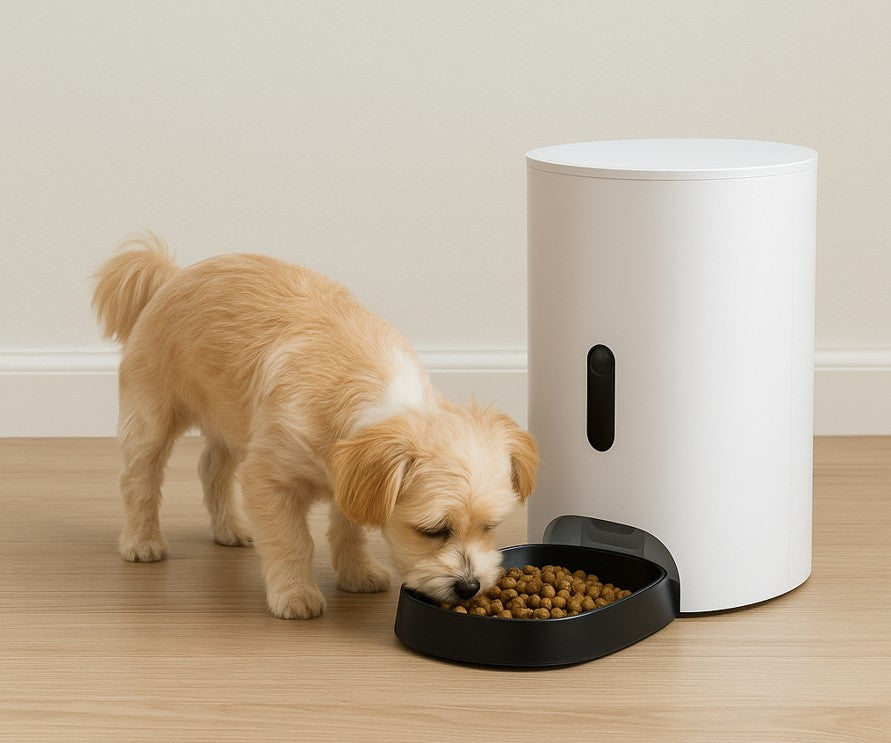
How Automatic Pet Feeders Actually Work
Ever caught yourself wondering what exactly happens inside those sleek little gadgets that feed your pets while you're out? Automatic pet feeders have become a staple for busy Aussie households—but they're more than just bowls with timers. From programmable trays to smart app integration, these clever devices take the guesswork out of feeding routines and offer peace of mind when life gets hectic.
In this guide, we’ll lift the lid (literally and figuratively) on how automatic pet feeders actually work, breaking down the parts, the tech, and the real-world benefits.
What Is an Automatic Pet Feeder?
An automatic pet feeder is a device designed to dispense a set amount of pet food at pre-scheduled times—no human required. Think of it as a robot butler for your furry mate’s meals.
While some feeders operate on simple gravity-based systems, others are programmable and packed with smart features like Wi-Fi connectivity, cameras, and custom feeding logs. Whether you’ve got a food-motivated Labrador or a picky Burmese cat, there’s likely a feeder that suits your routine.
The Core Parts of an Automatic Pet Feeder
To understand how they work, you need to get familiar with the key components inside every automatic feeder:
🐾 Hopper (Food Storage Unit)
This is where the dry food is stored. Hoppers come in various sizes, ranging from small 1-litre containers for toy breeds to bulkier 6-litre units ideal for large dogs or multiple pets. Most are made from BPA-free plastic or stainless steel to keep food fresh and hygienic.
⚙️ Dispensing Mechanism
The hero of the story. This mechanism controls how and when food leaves the hopper and lands in the feeding bowl. Depending on the feeder, this may be a rotating tray, an auger system (think of a screw turning), or a gravity-fed chute with a blocker.
⏲ Timer or Scheduling Interface
Basic feeders use manual dials or buttons to set feeding times, while more advanced models have digital displays or connect to your phone via a mobile app. This is what lets you automate breakfast at 6am—even while you’re still snoozing.
🔋 Power Source
Most feeders are powered by electricity, batteries, or both. Dual-power designs are particularly useful in areas with frequent outages, keeping your pet’s meals on track even when the lights go out.
📱 Smart Features (on Premium Models)
High-end feeders now offer Wi-Fi connectivity, live-feed cameras, voice messages, health tracking, and smartphone control. These systems sync with your device to offer real-time updates on feeding activity and allow remote schedule adjustments.
How the Food Dispensing Mechanism Works
Let’s break down how these devices physically deliver the food:
1. Rotating Tray Models
Popular for cats and small dogs, these feeders have a circular tray divided into compartments. Each compartment holds a meal, and the tray rotates to reveal the right one at the scheduled time.
2. Auger Mechanism (Screw Dispenser)
In most vertical feeders, a rotating auger (a bit like the spiral inside a sausage maker) pushes a measured amount of food through a small opening. This is better suited for kibble than wet or semi-moist food.
3. Conveyor Belt System
Less common but ultra-precise, these feeders use a belt to deliver food portions gradually. Ideal for pets on a strict vet-prescribed diet.
4. Gravity Feeders
No electronics here. As the pet eats, more food drops from the storage container to the bowl. Simple and hands-off, but not ideal for portion control or over-eaters.
Analogy time: If you’ve ever used a capsule coffee machine, think of an automatic feeder as the pet version. Food goes in the top, a mechanism releases it at just the right time, and voilà—dinner is served.
How Smart Technology Enhances Pet Feeders
Modern automatic feeders are doing more than sticking to a schedule—they're integrating into your home’s smart ecosystem.
Smartphone Apps
Most smart feeders let you download a companion app. From here, you can:
-
Adjust feeding times
-
Monitor if your pet has eaten
-
Track feeding logs
-
Manually dispense extra portions
Built-in Cameras & Two-Way Audio
Worried your dog hasn’t touched his breakfast? Some feeders include cameras with night vision, motion sensors, and even microphones so you can talk to your pet during mealtimes.
AI & Feeding Analytics
Advanced models can track how much your pet eats and flag changes in feeding behaviour—ideal for early detection of health issues.
Are Automatic Pet Feeders Safe?
In most cases, yes—provided you buy from a reputable brand.
✅ Pros:
-
Portion control: Great for weight management and pets with special dietary needs.
-
Routine: Consistent feeding even when you're running late or away for a weekend.
-
Peace of mind: No more frantic dashes home at lunch.
⚠️ Things to Watch For:
-
Jammed kibble: Always use the recommended kibble size.
-
Smart failures: Cheap knock-offs may have poor app support or unreliable Wi-Fi.
-
Pet tampering: Clever paws can sometimes break into poorly sealed hoppers.
Look for models with anti-jam sensors, locking lids, and BPA-free construction for safety.
When Are Auto Feeders Ideal?
Automatic feeders are perfect for:
-
🕔 Busy professionals who can’t always be home at the same time daily
-
🧳 Travellers going on short weekend trips
-
🐶 Pets on strict feeding schedules, like those with diabetes or allergies
-
🐾 Multi-pet households needing staggered or separate meals
-
🐱 Cats who prefer grazing rather than scarfing down meals
That said, they’re not a full replacement for human care—especially if your pet needs medications, supervision, or special prep meals.
Whether you’re working late, stuck in traffic, or just trying to create a consistent routine, automatic pet feeders can be an absolute game-changer for modern Aussie households.
Understanding how these devices work—inside and out—helps you choose the right one and use it with confidence. With so many smart features and styles to suit all pet sizes and lifestyles, there’s never been a better time to automate your pet’s meals.
FAQs
Can they dispense wet food?
Some can, but it's tricky. Wet food feeders use ice packs and sealed trays, but freshness is only maintained for a few hours.
Will it work if my Wi-Fi drops out?
Most feeders still function on their last saved schedule, but remote commands may fail.
Do they track my pet’s eating habits?
Smart feeders do. They record when, how much, and sometimes how often your pet eats.
How do I clean it?
Choose feeders with removable, dishwasher-safe parts. Clean weekly or more often for wet food trays.










Leave a comment